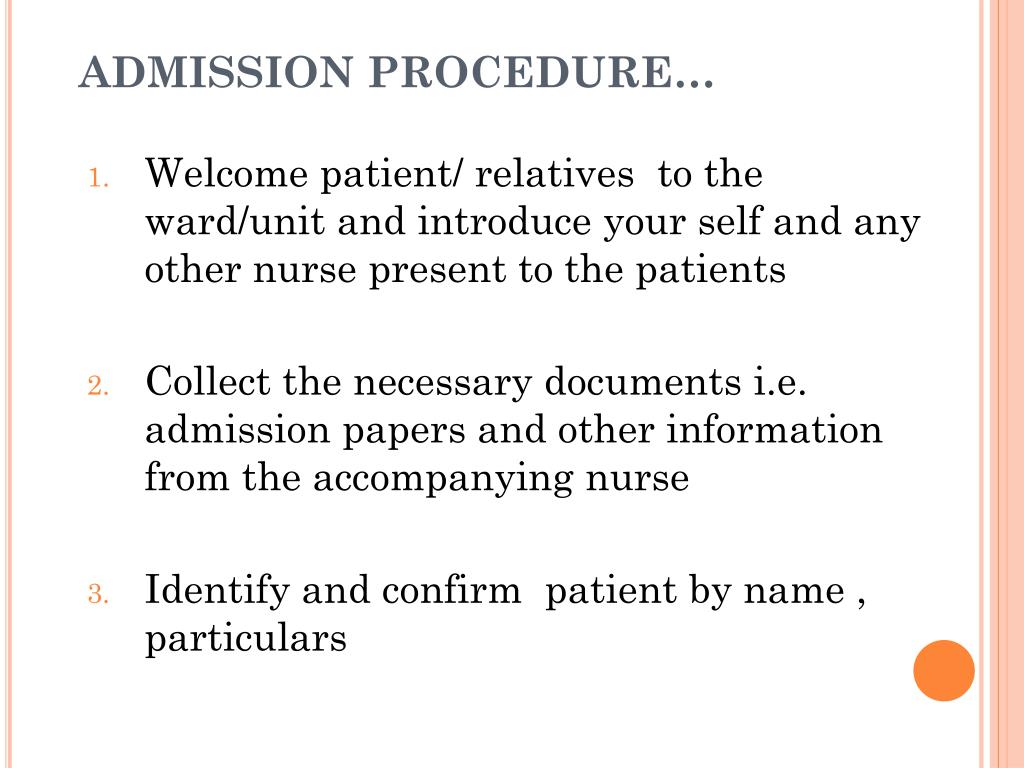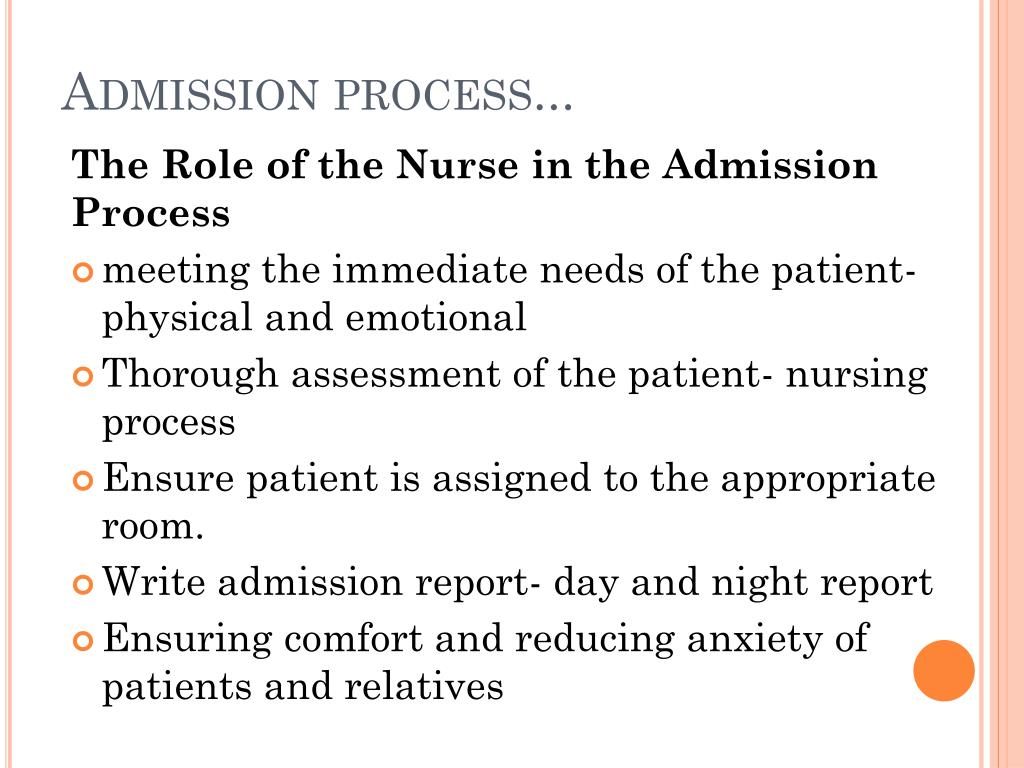Comprehensive Guide to Patient Admission Procedure: Advance Directive, Patient Rights, and Essential Tests
What is the patient admission procedure?. The patient admission procedure involves various steps to ensure the patient’s comfort, safety, and comprehensive care. It includes collecting important information, assessing the patient’s condition, developing a nursing care plan, and addressing the patient’s needs and concerns.
Understanding the Patient Admission Procedure
The patient admission procedure is a crucial process that hospitals and healthcare facilities follow when a patient enters their care. This procedure is designed to ensure the smooth transition of the patient into the healthcare setting, while also collecting important information, assessing the patient’s condition, and developing a comprehensive plan of care.
Key Components of the Patient Admission Procedure
The patient admission procedure typically consists of the following key components:
Authorization and Documentation
The admission process begins with obtaining authorization from a physician that the patient requires specialized care and treatment. The admitting department then collects billing information and completes the healthcare agency’s admission database, including documentation of the patient’s medical history and findings from the physical examination.

Initial Nursing Care Plan
Based on the information gathered, the nursing staff develops an initial nursing care plan to address the patient’s immediate needs and guide the ongoing care during their stay.
Initial Medical Orders
The physician provides initial medical orders for the patient’s treatment, which the nursing staff will then execute and monitor throughout the patient’s stay.
Addressing Patient Needs and Concerns
A crucial aspect of the patient admission procedure is ensuring that the patient feels welcome, comfortable, and at ease. Nurses play a vital role in this process by:
Orienting the Patient and Relatives
Nurses should orient the patient and their relatives to the hospital and ward policies, as well as the daily routine and expectations. This helps the patient feel more informed and in control of their care.
Recognizing and Meeting Patient Needs
Nurses should recognize the various physical, emotional, and psychological needs of the patient and address them without delay. This includes understanding and helping the patient overcome their fears and anxieties, as well as incorporating the patient’s preferences and dislikes into their care plan.

Establishing a Positive Relationship
Nurses should make every effort to be friendly, courteous, and attentive to the patient, addressing them by name and proper title. This helps to build a positive initial relationship and promote the patient’s cooperation and receptivity to treatment.
Advance Directive and Patient Rights
During the admission process, it is also important to address the patient’s advance directive and ensure their rights are respected. This includes:
Advance Directive
The nurse should inquire about the patient’s advance directive, which outlines their wishes for medical treatment in the event they become unable to make decisions for themselves. This document is crucial in guiding the patient’s care and ensuring their preferences are honored.
Patient Rights
The nurse should also inform the patient of their rights, such as the right to privacy, the right to make informed decisions about their care, and the right to refuse treatment. Respecting these rights is essential in providing patient-centered care.

Essential Tests and Assessments
As part of the admission process, the healthcare team will conduct various tests and assessments to gather more information about the patient’s condition and guide their treatment plan. These may include:
Physical Examination
The nurse will perform a comprehensive physical examination to assess the patient’s overall health status, identify any immediate concerns, and gather baseline data.
Diagnostic Tests
Depending on the patient’s condition and the reason for admission, the healthcare team may order various diagnostic tests, such as bloodwork, imaging studies, or specialized procedures, to help diagnose the patient’s condition and guide their treatment.
Ongoing Monitoring and Assessment
Throughout the patient’s stay, the nursing staff will continue to monitor the patient’s condition, observe for any changes or complications, and regularly assess the effectiveness of the treatment plan.
Conclusion
The patient admission procedure is a critical component of the healthcare process, ensuring the smooth transition of the patient into the care setting and the development of a comprehensive plan to address their needs. By understanding the key elements of this procedure, healthcare providers can work to create a welcoming, safe, and patient-centered experience for every individual who enters their care.

PATIENT ADMISSION – NURSING PROCEDURE
- Home
- ACCOUNT
Sign in
Welcome!Log into your account
your username
your password
Forgot your password?
Create an account
Privacy Policy
Sign up
Welcome!Register for an account
your email
your username
A password will be e-mailed to you.
Privacy Policy
Password recovery
Recover your password
your email
Search
– Advertisement –
NURSING PROCEDURES LIST CLICK HERE
NURSING IMPORTANT QUESTIONS – CLICK HERE
NURSE FUNDAMENTAL PROCEDURES
MEDICAL SURGICAL NURSING
Patient
admission, hospital stays and discharges follow an established procedure, i.e.
planned nursing activities. For patients requiring long-term care and repeated
hospitalization, the activities must be coordinated so that the nursing care is
continuous. The specific medical treatment prescribed by the doctor, and the
The specific medical treatment prescribed by the doctor, and the
nursing regime followed by the nurse, are administered by the nurse in order to
meet patient needs. The nurse monitors patient responses throughout the stay.
ADMISSION PROCEDURE
Admission to
the nursing unit prepares the patient for his stay in the health care facility.
Whether the admission is scheduled or follows emergency treatment.
Definition
- Admission is defined as allowing a
patient to stay in hospital for observation, investigation, treatment and care - Admission is the entry of a patient
into a hospital/ward for therapeutic or diagnostic purposes
Purpose
- To establish guidelines regarding
admission of patients - To make the patient feel welcome,
comfortable and at ease - To acquire vital information
regarding the patient - To assess the patient from which the
nursing care plan can be initiated and implemented
Principle Involved
- Sudden change or strangeness on the
environment produces fear and anxiety - Entering the hospital is a threat to
one’s personal identity - People have diversity of habits and
modes of behavior - Illness can be novel experience for
the patient and bring stress on his physical and mental health
General Instructions
- To receive the patient and help him
to adjust to the hospital environment - To welcome and establish a positive
initial relationship with the patient and relatives - To obtain the needed identifying data
concerning the patient - To provide immediate care, safety and
comfort - To collaborate with patient in
planning and providing comprehensive care - To observe, report signs and symptoms
and general condition of the patient - To secure safety of the patient and
his belongings
Effective admission
procedures should accomplish the following goals:
- Verify the patient’s identity and
assess his clinical status - Make him as comfortable as possible
- Introduce him to his roommates and
the staff - Orient him to the environment and
routine - Provide supplies and special
equipment needed for daily care
Admission
routines that are efficient and show appropriate concern for the patient can
ease his anxiety and promote cooperation and receptivity to treatment.
Conversely, admission routines that the patient perceives as careless or
excessively impersonal can lead to:
- Heighten anxiety
- Reduce cooperation
- Impair his response to treatment
- Perhaps aggravate symptoms
Types of Admission
- Emergency admission: means the
patient are admitted in acute conditions requiring immediate treatment, e.g. patient
with accidents poisoning, burns and heart attacks - Routine admission: the patients are
admitted for investigation and medical or surgical treatment is given
accordingly, e.g. patients with hypertension, diabetes and bronchitis
Admission
Involves
- Authorization from a physician that
the person requires specialized care and treatment - Collection of billing information by
the admitting department of the health care agency - Completion of the agency’s admission
data base by nursing personnel - Documentation of the client’s medical
history and findings from physical examination - Development of an initial nursing
care plan - Initial medical orders for treatment
- Medical authorization
- The admitting department (preliminary
data collected, addessography plate) - Initial nursing plan for care
- Medical admission responsibilities
General Instructions
- Nurses should make every effort to
the friendly and courteous with the patient - Make proper observations of the
patient’s condition, record and report - Orient the patient and his relatives
to hospital and ward policies - Observe policies in dealing with
medicolegal cases - Deal with the patients belonging very
carefully communicable diseases - Insolate the patient if suffering
from communicable diseases - The nurse should recognize the
various needs of the patient and meet them without delay - The needs to understand the fears and
anxieties of patient and help to overcome - The nurse should find out the likes
and dislikes of the patient and include the patient in his plan of care - The nurse should address the patients
by their name and proper title - Patient’s valuables and cloths should
hand over to the relatives with proper recording
Equipment
Gown,
personal property form, valuables envelope, admission form, nursing assessment
form, thermometer, emesis basin, bedpan or urinal, bath basin, water pitcher,
cup, and tray, urine specimen container, if needed. An admission pack usually
An admission pack usually
contains soap, comb, toothbrush, toothpaste, mouthwash, water pitcher, cup,
tray, lotion, facial tissues, and thermometer. An admission pack helps prevent
cross-contamination and increases nursing efficiency
Preparation of Equipment
- Obtain a gown and an admission pack
- Position the bed as the patient’s
condition requires. If the patient is ambulatory, place the bed in the low
position; if he is arriving on a stretcher, place the bed in the high position - Fold down the top linens
- Prepare any emergency or special
equipment, such as oxygen or suction, as needed
Preparation of the Patient
- Greet the patient and his relatives
and introduce yourself to them - Receive the patient cordially and
seat comfortable - Introduce him to other person in the
ward - Complete the admission record
- Collect history and carry out simple
physical examination - Carry out the prescribed treatment
and keep a record - Help the patient to maintain personal
hygiene and change into hospital clothes - Orient the patient to the ward-toilet
bath room, drinking water supply, nurse’s station and treatment room - Hand over the patients valuable to
his relatives - Issue visitor pass
- Encourage patient to take hospital
diet especially when therapeutic diet is ordered - Obtain local address or telephone
number, relatives lodge room and document in admission record
Procedure
- Adjust the room lights, temperature
and ventilation - Make sure all equipment is in working
order prior to the patient’s admission - Admitting the adult patient
- Speak slowly and clearly, greet the
patient by his proper name, and introduce yourself and any staff present - Compare the name and number on the
patient’s identification bracelet with that listed on the admission form. Verify
Verify
the name and its spelling with the patient. Notify the admission office of any
corrections - Quickly review the admission form and
the physician’s orders. Note the reason for admission, any restrictions on
activity or diet, and any orders for diagnostic tests requiring specimen
collection - Escort the patient to his room and, if
he is not in great distress, introduce him to his roommate. Then wash your
hands, and help him change into a gown or pajamas; if the patient is sharing a
room, provide privacy - Take and record the patient’s vital signs
and collect specimens if ordered. Measure his height and weight if possible. If
he cannot stand, use a chair or bed scale and ask him his height. Knowing the
patient’s height and weight is important for planning treatment and diet and
for calculating medication and anesthetic dosages - Show the patient how to use the
equipment in his room. Be sure to include the call system, bed controls, TV
controls, telephone and lights - Explain the routine at your health
care facility. Mention when to expect meals, vital sign checks and medications.
Mention when to expect meals, vital sign checks and medications.
Review visiting hours and any restrictions - Take a complete patient history.
Include all previous hospitalizations illnesses, and surgeries; current drug
therapy; and food or drug allergies. Ask the patient to tell you why he came to
the facility. Record the answers (in the patient’s own words) as the chief
complaint. Follow up with a physical assessment, emphasizing complaints. Record
any wounds, marks, bruises or discoloration on the nursing assessment form - After assessing the patient, inform
him of any tests that have been ordered and when they are scheduled. Describe
what he should expect - Before leaving the patient’s room,
make sure he is comfortable and safe. Adjust his bed, and place the call button
and other equipment (such as water pitcher and cup, emesis basin, and facial
tissues) within easy reach. Raise the side rails
Using Patient Care reminders
When placed
at the head of the patient’s bed, care reminders call attention to the
patient’s special needs and help ensure consistent care by communicating these
needs to the hospital staff, the patient’s family and other visitors. You can a
You can a
specially designed card or a plain piece of paper to post important information
about the patient, such as:
- Allergies
- Dietary restrictions
- Fluid restrictions
- Specimen collection
- Patient deaf or hearing-impaired in
right ear - Foreign-language speaker. You can
also use care reminders to post special instructions, such as: - Complete bed rest
- No blood pressure on right arm
- Turn every 1 hour
- Nothing by mouth
Admitting the Pediatric Patient
- Your initial goal will be to
establish a friendly, trusting relationship with the child and his parents to
help relieve fears and anxiety - Speak directly to the child, and
allow him to answer questions before obtaining more information from his
parents - While orienting the parents and child
to the unit, describes the layout of the room and bathroom, and tells them the
location of the playroom, television room, and snack room, if available - Teach the child how to call the nurse
- Explain the facility’s rooming in and
visiting policies so the parents can take every opportunity to be with their
child - Inquire about the child’s usual routine
so that favorite foods, bedtime rituals, toileting, and adequate rest can be
incorporated into the routine - Encourage the parents to bring some
of their child’s favorite toys, blankets, or other items to make the child feel
more at home amid unfamiliar surroundings
Special Considerations
- If the patient does not speak English
and is not accompanied by a bilingual family member, contact the appropriate
resource - Keep in mind that the patient
admitted to the emergency department requires special procedures - If the patient brings medications
from home, take an inventory and record this information on the nursing
assessment form. Instruct the patient not to take any medication unless
Instruct the patient not to take any medication unless
authorized by the physician - Find out the patient’s normal
routine, and ask him if he would like to make any adjustments to the facility
regimen
Documentation
After
leaving the patient’s room, complete the nursing assessment form or your notes,
as required. The completed from should include the patient’s vital signs,
height, weight, allergies, and drug and health history; a list of his
belongings and those sent home with family members; the results of your
physical assessment; and a record of specimens collected for laboratory tests
Legal Aspects of Patient Admission
- Providing information about the
patient to family members and to the next of kin is governed by applicable
legislation - In the case of acutely ill patients
who cannot express consent with hospitalization (e.g. unconscious, following
strokes, etc) a detention procedure or the “procedure concerning patient
admission and detention by a healthcare facility” is put into place. The
The
healthcare provider reports the patient admission without their consent to the
court - Under emergency hospitalization, the
court will appoint a guardian to represent the patient during detention
NURSES ROLE IN ADMISSION
Admission to
an acute hospital may be planned (elective) or may be required as a matter of
urgency (emergency). Elective admissions are those which occur as a consequence
of referral to hospital by a general practitioner, medical consultant, a visit
to the hospital outpatient department or a planned transfer from another
hospital. Some patients may confound these definitions, e.g. patients requiring
chemotherapy who may be both urgent and planned. A number of principles should
underpin the development of an effective emergency and elective admissions and
discharge planning function. These include:
- The provision of patient centered
services, which are accessible to the population without compromising safety,
quality and clinical standards, to the right people in the right location and
at the right time - Patients should be consulted and
included in all decisions about their care - Clinical practice and care should be
based on the most up to date evidence - Cooperation and clinical networking
between hospitals and between care groups are essential to optimize outcomes,
particularly where complex care issues are involved - A service based on good clinical
governance (i. e. founded on continuous quality improvement, staff development,
e. founded on continuous quality improvement, staff development,
risk management and audit) - Acute hospital services should be
organized into three parallel streams of care interdependent of each other.
This involves a division of acute hospital services into emergency, elective
and out patients department/day care - The pivotal role of the Primary Care
Teams should be emphasized - Early induction training of
healthcare professionals in relation to the principles set out above
The
effective management of hospital beds and associated resources is vital if the
growing demand placed on hospital resources is to be met. Recognized
impediments to patient “flow” in hospitals include:
- Difficulties in gaining access to
inpatient beds (i.e. insufficient bed capacity) - The resulting congestion within
Emergency Departments - Inappropriate retention of patients
in hospital beds
To ensure
that all patients admitted to hospital receive the high quality and safe
service to which they are entitled, resources must be efficiently and
effectively utilized. Services are organized so that patients, depending on
Services are organized so that patients, depending on
their needs, can move smoothly between emergency care and the best and most
appropriate inpatient care, primary care and continuing care. Effective quality
assurance and safe care are essential rights of all users of the health
services. Achieving the standards set by the Irish Health Services
Accreditation Board will ensure that all hospitals are providing such care
EMERGENCY ADMISSIONS
An emergency
hospital admission is defined as one that is not planned and which results from
trauma (injury) or acute illness which cannot be treated on an outpatient
basis. In order to manage the balance between elective and emergency
admissions, the factors below have been identified as effective in improving
the management of admissions and general patient flow in the Emergency
Department
Managing
emergency admissions: for the patient admitted through the emergency department
(ED), immediate treatment take priority over routine admission procedures.
After ED treatment, the patient arrives on the nursing unit with a temporary
identification bracelet, a physician’s order sheet, and a record of
treatment. Read this record and talk to
the nurse who cared for the patient in the ED to ensure continuity of care and
to gain insight into the patient’s condition and behavior. Next, record any
ongoing treatment, such as an IV infusion, in your notes. Take and record the
patient’s vital signs, and follow the physician’s orders for treatment. if
family members accompany the patient, ask them to wait in the lounge while you
assess the patient and begin treatment. Permit them to visit the patient after
he’s settled in his room. When the patient’s conditions allows, precede with
routine admission procedures.
ELECTIVE ADMISSIONS
Achieving
the correct balance the competing demands for hospital beds by elective and
emergency cases of varying complexity is likely to remain a considerable challenge
for the future. In order to improve the experience of patients waiting for
elective admission, the following priorities have been identified:
- Local clinical consensus on the ratio
of emergency admissions to planned elective procedures - Measures to review and monitor
criteria for hospital admission and for lengths of stay - Greater emphasis on ensuring that in
admitting elective patients, consideration is given to the length of time they
have been waiting since the decision to admit was taken – taking account of
their clinical needs - Greater standardization of waiting
list administration with consistent monitoring of cancellations, suspensions
and removal from lists without treatment.
- Emphasis on planning discharge from
day of admission - The adoption of a whole systems
approach to bed management - The appointment of a manager or
clinician with sufficient authority and support to balance and monitor the
competing demands of emergency and elective pressures ensuring all bed and
theatre resources are fully utilized
A patient’s
episode of care should be planned before his/her admission and should take
account of the entire “journey” up to and after discharge from hospital.
Patients and their care taker should be partners in the planning. Bed management
should be overseen by a Hospital Bed Manager who has the authority to implement
the bed management policy and to coordinate the bed management team. The bed
management service should operate on a permanent basis, i.e. for 24 hours on
everyday of the year. The bed manager reports to a senior member of management.
Part of their role would include continuous analysis and the provision of
reports and forecasts. The function of allocating beds to patients should be
The function of allocating beds to patients should be
centralized and the Hospital Bed Manager should have authority over the access
to all hospital beds. There should be an awareness of the bed designation ratio
as set out by the Department of Health and Children. The Hospital Bed Manager
should work within the notional allocation of beds to each specialty to ensure
that patients are accommodated in the most appropriate bed available at the
time of their admission, and to ensure that patients are cared for by staff
with the appropriate expertise
The
following key requirements have been identified to facilitate effective
elective admission practices:
- Centralized waiting list management
and agreement on the parameters for scheduling theatre lists with clinicians - Pre-admission assessment should be
standard requirement for all elective admissions to ensure appropriate planning
of the entire patient journey - The anticipated length of stay (this
should be indicated as early as possible to facilitate scheduling) for elective
admissions should be indicated as early as possible to facilitate scheduling - Increased day surgery can also the
supported by before admission assessment to ensure appropriate scheduling and
to minimize transfer to in-patient beds
PATIENT TRANSFER – NURSING PROCEDURE
PATIENT DISCHARGE – NURSING PROCEDURE
PATIENT ADMISSION – NURSING PROCEDURE
Definition, General Instructions, Equipment, Nurses role in Admission Procedure, Types of Admission
– Advertisement –
– Advertisement –
Related article
admission procedure in nursing
admission procedure in nursing
Advertisement
1 of 19
Top clipped slide
Health & Medicine
admission procedure in nursing
Advertisement
Advertisement
Advertisement
admission procedure in nursing
- ANILKUMAR BR
LECTURER
MEDICAL SURGICAL NURSING - HOSPITAL
ADMISSION AND
DISCHARGE - Admission to the hospital
Unit and it’s preparation admission
bed
Admission procedure
Special consideration
Medico-legal issues
Role and responsibilities of the nurse - Discharge from the hospital
Types : Planned, LAMA, Abscond,
Referrals and Transfers
Discharge planning
Discharge procedure - Continue.
 .
.
• Discharge procedure
• Special considerations
• Medico-legal issues
• Role and responsibilities of the nurse
• Care of the unit after discharge - ADMISSION
- Admission is defined as allowing a
patient to stay in hospital for
observation, investigation, treatment
and care. - Admission is the entry of a patient into a
hospital /ward for therapeutic /diagnostic
purposes. - Types of admission
1) Emergency admission
2) Routine admission - Emergency admission : in this, patients
are admitted in acute conditions requiring
immediate treatment. Examples. Patient
with RTA, Poisoning, burns and cardiac
or respiratory emergency. - Routine admission : in this, patients are
admitted for investigation, diagnostic and
medical or surgical treatment. Treatment
is given according to patients problem.
Examples patient with hypertension,
diabetes mellitus etc. - UNIT AND IT’S PREPARATION
Unit: It is a place where the patient is kept
during hospital stay.
The admitting department notifies the unit
prior to the patients arrival so that room
/bed can be prepared. - Unit‘s and it’s preparation
Prepare the treatment table
Ensure all the equipment are completed
Check ventilation
Ensure patient privacy - SPECIAL CONSDIRATION
Admission cause undue stress (emotional
factors as well as financial capability must
given utmost importance)
Be observant consider the individual patient
needs
Provide an individual admission procedure
show may efficiency and concerns - Admission procedure
Meet and receive the patient
– Verify the patient data, by checking the
record sheet, chart
– Introduce immediate personal
– Assist patient to the treatment area
– Ask the patient to change clothes into
hospital gown if necessary - Perform examination and evaluation
procedure.
Perform examination and evaluation
procedure establish base line valves like vital
signs, do history taking, physical examination
etc.
Coordinate with the physician and carry out
initial orders
Give the treatment and instructions as need - Orientation to the patient and others
The equipments /instruments
Use of call system and telephone
Treatment schedule
Vistors timings
Other health care team members
Policy and rules and regulations
Care of patients valuable etc - Role and responsibilities of nurse in
admission procedure :
Nurse should deal every effort to be
friendly and courteous with the patient
and family members
Make proper observation of patients
condition - Continue
Orient patient and relatives regarding
hospital polices
Deal with patient carefully who is suffering
from communicable disease or illness.
Isolate if necessary
Patients valuables and clothes should be
handed over to relatives with proper
recording.
Advertisement
Rules for organizing the reception of patients
1 . These rules define the conditions for organizing the reception of patients in the polyclinic.
2. When contacting the clinic, patients present the CHI policy and an identity document. Citizens who have the right to receive a set of social services additionally present SNILS.
3. At the initial visit, an outpatient medical card is entered for the patient, in which the following information about the patient is entered: last name, first name, patronymic (in full), date of birth (day, month, year), address according to registration (registration) ) on the basis of identity documents (passport) series and number of the passport, series and number of the patient’s medical insurance policy. Informed voluntary consent to the provision of medical services and the processing of personal data is filled out.
4. Patients are served in the registry on a first-come, first-served basis, veterans of the Great Patriotic War, family members of the dead (deceased) disabled war veterans, combat veterans, participants in the liquidation of the consequences of the Chernobyl accident, disabled people due to the Chernobyl disaster, pregnant women, sick with high fever and acute pain of any localization, bleeding (in the direction of the emergency room).
5. Patients requiring emergency medical care or urgent medical care are referred to the emergency room.
6. Appointments with the doctor are carried out during his working hours at the time indicated in the coupon or at the time agreed with the doctor. In case of delay, the patient can be accepted if there are free places in the schedule. A patient scheduled outside of the schedule is waiting for a personal invitation to the office. The date and time of the return visit is determined by the doctor.
7. Patients who made an appointment with a doctor by appointment (via a multi-line phone of the call center, via the Internet, etc.), must contact the receptionist no later than 20 minutes to clarify the availability of an outpatient card and receive a statistical ticket.
8. The right to extraordinary medical care in medical organizations is granted to the following categories of citizens:
- disabled veterans of the Second World War;
- participants of the Great Patriotic War;
- soldiers-internationalists;
- Heroes of the Soviet Union, Russian Federation, full holders of the Order of Glory, Heroes of Socialist Labor;
- persons exposed to radiation as a result of the accident at the Chernobyl nuclear power plant and similar facilities;
- former underage prisoners of fascist concentration camps;
- citizens who suffered from political repressions, rehabilitated;
- widows of fallen (deceased) veterans of the Great Patriotic War;
- persons awarded with the badge “Honorary Donor of Russia”;
- mothers of many children;
- medical workers
All persons eligible for an emergency appointment are invited to the doctor’s office by a nurse.
9. Extraordinary admission for emergency indications is carried out in the presence of a special marked coupon issued in the pre-medical appointment.
10. Payment for medical services does not grant the right to extraordinary services to the detriment of citizens receiving free medical care under the Territorial Program of State Guarantees.
11. Examination and treatment of conscripts in the direction of the commission of the military registration and enlistment office and patients undergoing medical examination are carried out as a matter of priority.
12. Persons recognized as legally incompetent in accordance with the current law are provided with medical assistance in the presence of their legal representatives. The powers of the representative must be expressed in a power of attorney issued and executed in accordance with the law. (Article 53 Code of Civil Procedure of the Russian Federation)
13. In case of a long waiting period for a doctor’s appointment, the medical registrar is obliged to offer the citizen the opportunity to contact another doctor of the relevant specialty.
In case of a long waiting period for a doctor’s appointment, the medical registrar is obliged to offer the citizen the opportunity to contact another doctor of the relevant specialty.
Rules for the admission of patients – STOM SERVICE
RULES for the admission of patients
DEAR PATIENT!
You applied for medical assistance to OOO Stomservice (hereinafter referred to as the Polyclinic).
Your attending physician and the Polyclinic team will make every effort to ensure that you receive adequate medical care. In order for the process of your treatment to be more organized, we ask you to pay attention to the Rules adopted in our “Polyclinic”.
1. Do not leave your belongings unattended during your stay at the Polyclinic: the staff cannot take responsibility for their safety.
2. When you first apply to you at the registry office, they will issue primary medical documentation (account form No. 043 / u “Medical card of a dental patient”), they will conclude an Agreement for the provision of paid medical services only at your personal request.
3. Please provide your passport. Your Dental Patient Record is kept at the registry.
4. In order to get advice from a specialist who can provide the most effective assistance, you need to describe the essence of the problem in as much detail as possible to the medical registrar of the Polyclinic. In this case, you will be allocated a time convenient for you and the specialist whose qualifications correspond to this profile.
5. Please fill out the Health Questionnaire before your appointment, and at the appointment, answer additional questions about your health status from a specialist doctor. Your doctor, if necessary, may refer you for additional examinations.
6. We ask you to come to the doctor’s appointment at the exact time, and if any circumstance interferes with your visit, inform the reception in advance. If you are more than 15 minutes late for your appointment without notifying your doctor, your treatment will not be performed that day.
7. Please note that in exceptional cases, when your doctor provides emergency care to another patient in an emergency, the start of your appointment may be delayed.
Please note that in exceptional cases, when your doctor provides emergency care to another patient in an emergency, the start of your appointment may be delayed.
8. In accordance with Article 20 of the Federal Law No. 323-FZ of November 21, 2011 “On the Basics of Protecting the Health of Citizens in the Russian Federation”, as amended of June 25, 2012 No. 93-FZ, a necessary precondition for medical intervention is the provision of informed voluntary consent of a citizen or his legal representative for medical intervention on the basis of complete information provided by a medical professional in an accessible and understandable form about the goals, methods of providing medical care, the associated risk, possible options for medical intervention, its consequences, as well as the expected results of providing medical care.
9. Informed voluntary consent to medical intervention or refusal of medical intervention is made in writing, personally signed by a citizen or his legal representative, a medical worker and is contained in the patient’s primary medical records.
You must know everything related to health, treatment and manipulations carried out by polyclinic specialists and make an informed decision regarding the upcoming medical intervention.
1. Our specialists honestly warn the patient about the unfavorable factors of a specific medical intervention, possible complications in the course of treatment, do not sign their helplessness. On the contrary, demonstrating their professional responsibility, specialists undertake to do everything possible to prevent possible deviations from the desired result, but, if they do occur, to do everything in their power to eliminate them. Thus, informed voluntary consent to certain types of medical intervention gives you the opportunity to be a full participant in the decision-making: to be treated or refuse under the proposed conditions.
2. If you refuse to read and sign the informed voluntary consent, the doctor will make an appropriate entry in your medical record. Any medical worker of the “Polyclinic” will confirm with his signature the fact that the DOCTOR SUGGESTED you to read the document, but you refused to read and sign it. This procedure is provided for by the legislation of the Russian Federation.
This procedure is provided for by the legislation of the Russian Federation.
3. Each doctor begins the initial consultation with a patient questioning, listens to his complaints and wishes. Try to explain to the doctor your problem (what hurts, what is the nature of the pain), whether you want to have dental prosthetics, dental implants, etc. During the consultation, the doctor will visually and with the help of an x-ray examination reveal your problems, on the basis of which a preliminary treatment plan will be drawn up for you and given relevant recommendations when choosing a technology for the treatment and diagnostic process and choosing a design for prosthetics. The final diagnosis can be made after consultations with related specialists of the “Polyclinic”, additional necessary examination, as well as in the course of treatment. You can ask your doctor all your questions, as well as find out about alternative treatments and how this or that treatment can affect your daily life in the future.
4. The polyclinic does not provide services under the program of state guarantees of free provision of medical care to citizens and the territorial program of state guarantees of free provision of medical care to citizens.
5. You will be asked to sign your consent with the proposed treatment plan, the design of the prosthesis and/or apparatus, materials, or the refusal of certain measures.
7. During the course of treatment and at the end of it, in order to achieve the best results, you must strictly follow all the doctor’s instructions regarding the regimen, the rules of individual oral hygiene, the use of restorations, prostheses or devices.
The timing of your treatment will depend on the volume, complexity of treatment, as well as on the characteristics of your body and your compliance with the doctor’s prescriptions. If you do not follow the recommendations of the doctor, then the provision of medical care becomes impossible. The patient’s refusal to follow the recommendations and regimen of the clinic is tantamount to revoking his previously given consent to treatment and termination of mutual obligations.
1. Payment for the provided medical services on a paid basis is made in the order of 100% (one hundred percent) prepayment for each appointment, that is, for those manipulations that were carried out at the time of the visit, in accordance with the Price List for paid medical services in force on the day of conclusion Contracts for the provision of paid medical services. Payment for dental services for dental prosthetics can be made in stages, by agreement with you: 1st visit in the amount of at least 30% -50% of the cost of prosthetics immediately after taking impressions when paying to the cash desk of the clinic in cash, through a bank terminal or in within 10 (ten) working days from the date of issuing the corresponding invoice when paying by bank transfer at the expense of employers’ funds and other funds on the basis of agreements. You must pay the remaining amount to the cash desk of the clinic no later than the day the specialist works, before the final fixation of the denture in the oral cavity or within 10 (ten) working days from the date of issuing the relevant invoice if paid by bank transfer at the expense of employers’ funds and other means on the basis of contracts.
2. Upon completion of your treatment on a paid basis, as well as the treatment of your family members, you can receive a certificate of the established form on payment for medical services to be submitted to the tax authorities of the Russian Federation in order to provide a tax deduction.
3. Please pay attention to the fact that the warranty periods and service periods for the provision of medical services, as well as the conditions for their operation, are defined in the “Regulations on the establishment of the warranty period”. In accordance with this Regulation, you will be provided with medical assistance to adjust the treatment performed by the Polyclinic specialists. If the rules prescribed by the doctor have not been violated and the necessary level of hygiene has been observed, then assistance will be provided free of charge.
4. In case of any, even minor signs of discomfort in the oral cavity (pain, namin, inflammatory reactions, mobility of bridges, etc. ), as well as in case of breakage of the prosthesis, please contact your doctor immediately.
), as well as in case of breakage of the prosthesis, please contact your doctor immediately.
Thank you for following our rules!
Administration of the Polyclinic.
RIGHTS AND OBLIGATIONS OF PATIENTS
Each patient, in accordance with Federal Law No. 323-FZ of November 21, 2011 “On the Basics of Protecting the Health of Citizens in the Russian Federation”, has the right to:
1. To protect health, to provide affordable and quality medical care.
2. Choice of a doctor (subject to the doctor’s consent) and choice of a medical organization.
3. Prevention, diagnosis, treatment, medical rehabilitation in conditions that meet sanitary and hygienic requirements.
4. Obtaining consultations from medical specialists.
5. Relief of pain associated with the disease and (or) medical intervention, available methods and drugs.
6. Obtaining information about one’s rights and obligations, the state of one’s health, choosing persons to whom, in the interests of the patient, information about the state of his health can be transferred.
7. Protection of information constituting a medical secret.
8. Refusal of medical intervention.
9. Compensation for harm caused to health during the provision of medical care.
Obligations of the patient:
1. Citizens are obliged to take care of their health.
2. Citizens, in cases provided for by the legislation of the Russian Federation, are required to undergo medical examinations, and citizens suffering from diseases that pose a danger to others, in cases provided for by the legislation of the Russian Federation, are required to undergo a medical examination and treatment, as well as engage in the prevention of these diseases .
3. Citizens undergoing treatment are required to comply with the treatment regimen, the Rules for Admitting Patients and the Rules for the Internal Work Order of the polyclinic.
4. In the premises of the polyclinic it is forbidden:
– to talk loudly, make noise;
– drinking alcoholic beverages;
– smoking;
– use of narcotic drugs, psychotropic and toxic substances;
– appearance in a state of alcoholic, narcotic and toxic intoxication, except for the need for emergency and emergency medical care;
– use of office phones and office equipment.
PROCEDURE FOR CITIZENS.
1. For the convenience of patients aged 18 years and older, an appointment with specialist doctors of the polyclinic is carried out upon personal contact with the receptionist, on the site of the polyclinic in the global information telecommunications network “Internet” – www.stom-service.rf.
2. The staff of the registry makes a preliminary appointment with the doctors of the polyclinic by phone: 51-52-18.
3. Appointments with medical specialists are made by appointment or on the same day.
4. For registration of primary medical documentation (registration form No. 043 / y “Medical record of a dental patient”), you must have an identity document with you;
5. In case of non-appearance at the appointed time, the appointment will be cancelled.
6. The patient is re-admitted on the day and time appointed by the doctor. Failure to appear on the appointed day is considered a violation of the regime.
7. If a conflict arises between a patient and a doctor, middle or junior medical staff, the dispute is resolved by the administrator or chief physician.
PROCEDURE FOR REGISTRATION OF MEDICAL DOCUMENTS.
1. The main medical document of the patient in the clinic is the “Medical record of the dental patient” registration form No. 043 / y.
2. Primary medical documentation is stored in the card index of the polyclinic registry.
3. The period of storage of the “Medical record of a dental patient” in the registry is 5 years from the date of the last application. Storage of medical records at home, its transfer to other medical institutions, third parties is prohibited, except as provided by law.
Dear citizens!
If you have questions:
violations of rights in the field of health care
medical care organizations
accessibility, quality and safety of medical care
sanitary condition of the premises of the Polyclinic
ethics and deontology of medical personnel
provision of fees medical services without registration contract
other questions related to your health
You can contact:
to the administrator,
to the director of the Polyclinic Korchevsky Vladimir Prokopevich
from 09.

 Verify
Verify Mention when to expect meals, vital sign checks and medications.
Mention when to expect meals, vital sign checks and medications. Instruct the patient not to take any medication unless
Instruct the patient not to take any medication unless The
The e. founded on continuous quality improvement, staff development,
e. founded on continuous quality improvement, staff development,
 .
.
